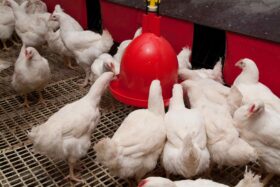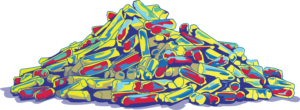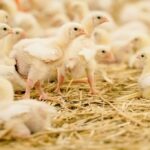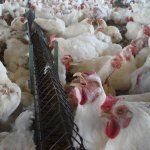By T.J. Gaydos
Water quality is a frequently overlooked part of animal production and it becomes even more important when producing animals in an antibiotic-free (ABF) system. Chickens drink almost twice as much water as they consume feed, and water hygiene is often a second-level priority. Microbes present in water can be primary or secondary pathogens or non-pathogenic. Consuming impure water can add a challenge to the immune system, negatively impacting performance.

Water hygiene is essential for achieving antibiotic-free poultry production
Significant resources are spent on the correct nutrients in the diet and the correct additives for bird health. Water quality should be a priority, and a water quality monitoring program is essential for success in an ABF program. All things being equal, animals will perform better if they have access to high-quality water.
The variability of water quality in the grow-out region should determine how many water quality samples are taken. In highly variable areas, water quality should be measured at every season change on enough farms in every region to know if the solutes are changing. If the water quality is good and consistent, monitoring may be reduced significantly. Water quality should be a part of a “problem farm” work up or related to otherwise unexplained poor performance.
Water-soluble additives: Prevent biofilm
The use of water-soluble products is common in ABF production systems and their frequent use may provide a carbon source for bacteria. This, along with warm temperatures and slow water flow in enclosed water systems, makes the perfect environment for biofilm development.
It is important to frequently flush lines, give birds access to fresh water between additives, and sanitize water lines after using a product that can provide nutrients to bacteria in the line. The biofilm is a perfect location to harbor and protect pathogens from acids and mild or under-dosed disinfectants.
Designing a water quality program
Sample collection
The first step to building a water quality program is to understand the challenge on every farm. Correct sample collection is critical to achieving good results. Take a water sample from as close to the well as possible and submit for water quality analysis: pH, hardness, and minerals. This sample should also be submitted for bacterial load: total aerobic plate count (CFU) per mL and total coliforms per mL.
Monitor bacterial load
A drip sample should be collected from the end of the line for bacterial load analysis as well. This will help determine if the bacterial challenge begins at the source or is limited to the house. Additionally, a swab from the inside of the end of the water line should be taken to determine the level of biofilm. The total bacterial count should be less than 1,000 CFU/mL without fecal coliforms in a free-flowing sample, and total bacteria should be less than 10,000 CFU/mL on a biofilm swab.
Monitor water pH
Water should have a pH between 5 and 8. Water with a pH consistently lower than 5 can be damaging to equipment, while a pH over 8 reduces the efficacy of many disinfectants and can have a bitter taste to birds. Hard water can increase scaling of lines and equipment, leading to leaking seals. Scale also provides a matrix for biofilm formation, making cleaning and disinfection more difficult.
Clean and disinfect water lines
Cleaning water lines between flocks is the minimum program for ABF production. Stabilized hydrogen peroxide products are excellent for disinfecting water lines between flocks. The levels needed for proper disinfection of lines are generally too strong for birds, and the lines must be flushed prior to bird placement.
Water lines are often only cleaned in the house; it is important to periodically clean the lines that transport water from the well or water source to the poultry house as this may be a significant reservoir for bacteria. If the well is identified as a source of contamination, it is essential to seek the help of a qualified technician before adding any sanitizing product to a wellhead.
Continuous disinfection
Ideally, water should be continuously disinfected with a product that is approved for poultry consumption. One of the best products for continuous disinfection is chlorine dioxide, which is effective at reducing bacteria and also reducing the concentrations of some mineral components. High levels of iron in the water can create a favorable environment for E. coli and other bacteria such as C. perfringens.
In addition to disinfection, chlorine dioxide is an effective treatment to reduce soluble iron levels. High sodium and chloride levels can lead to flushing and promote the growth of some bacteria. If high levels of sodium and chloride are consistent across a grow-out region, it may be possible to decrease the levels in the feed to reduce flushing. If the levels of sodium and chloride are considerably high, reverse osmosis should be considered to improve water quality.
Bottom line: invest in high-quality water
Another effective product is stabilized hydrogen peroxide at an appropriate residual level for bird consumption. There are other options for water line sanitation that can be explored on a case-by-case basis.
There are excellent online resources [link] for poultry water quality. The important message remains, in any case, that investment in high-quality water is a critical step for success in ABF poultry production.
References
Austin, B.J., J. Payne, S.E. Watkins, M. Daniels, and B.E. Haggard. 2016. How to Collect Your Water Sample and Interpret the Results for the Poultry Analytical Package. Arkansas Water Resources Center, Fayetteville, AR, FS-2017-01: 8 pp.
Scantling, M. and Watkins, S. 2013. Identify Poultry Water System Contamination Challenges. FSA8011. University of Arkansas Division of Agriculture Research and Extension.
Watkins, S. 2008. Water: Identifying and correcting challenges. Avian Advice 10(3):10-15. University of Arkansas Cooperative Extension Service, Fayetteville, AR

















